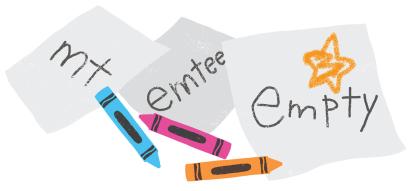Your preschooler is “helping” you make dinner. You need some sour cream. Your child needs to figure out which container has the sour cream—not the cottage cheese. Here’s a teachable moment: “Ssssour cream starts with the ssss sound, and we spell that sound with the letter s. Let’s look for the container with a word that has the letter s at the beginning!”
Teachable moments—opportunities to help children learn foundational reading skills—happen every day in our homes and communities. You can use these moments to complement the systematic instruction your child should be receiving at school (preschool and early elementary school). Here are some ways to take advantage of teachable moments.
Point Out Print
Children aren’t born knowing that letters have a special importance in our society. As toddlers or preschoolers, they may be just as interested in a door’s hinges as the sign on it. You can help your child understand that print is important by pointing it out and talking about its purpose. For example, when you see a stop sign, you can tell your child, “The letters on that sign spell ‘stop.’ They tell us to stop. They help us not crash into other cars.”
When you are reading a book or other text to your child, run your fingers along the words as you read. In addition to helping your child learn that the letters are telling you what to read/say, you are helping your child to understand the direction in which we read. For example, in English we read from left to right and top to bottom. As children grow, point out more advanced aspects of print, such as the exclamation point on a “Happy Birthday!” card or the search results that help you find what you’re looking for online.
Emphasize Sounds
Learning the names of letters is valuable, but learning the sound or sounds spelled by each letter is also important for your child’s development. For sounds to teach early on, see the box on the right for the English alphabet (if your home language uses a different writing system, teach that instead or as well!). When you are writing, say a sound aloud, invite your child to say it with you, and then show your child how to spell that sound. For example, if you are leaving a note to say that dinner is at six, emphasize the /d/ sound* as you say “d d dinner” and then explain that we spell that /d/ sound with the letter d. Show your child how you write the letter. Take care when you pronounce the sounds. Rather than saying “duh,” try to clip the vowel sound after the d sound as much as possible. And be sure to pronounce words and sounds the way you do in your dialect or way of speaking—children learn best when they can connect letters to the way you and they speak every day.
Name It
Research studies have found that children’s names are especially important for their early literacy development. Names often help children understand that print can represent the things we say. Children tend to learn the letters in their names before other letters. And a child’s name is often among the first words they write. Expose your child to their name often and give them lots of opportunities to write their name themselves. Early on, you can invite your child to watch you write their name as you demonstrate how to form each letter. (If possible, use whatever way of forming each letter is taught in the schools in your community.) Later, children can trace what you have written. As they work to write their names themselves, don’t worry if their name doesn’t look perfect; that will come with time.
Look for lots of authentic reasons for your child to write their name: to label clothing, to sign a card, to make a place card, and so on. And don’t worry if the way your child’s name is spelled doesn’t match the letter-sound relationships in the box on the right. This gives you an opportunity to help your child understand that there are often many ways to represent a sound. For example, in Ella and Niesha, the letter a spells the “uh” sound.
Write Away
Engaging young children in writing is great for their literacy development. Need help with a shopping list? A reminder note? A text message to a relative? Invite your child to help you write it! Early on, children often pretend to write, using scribbles or other marks that look more and more like letters over time. Next, children may use a combination of letters and other shapes. The letters children choose to write may have no relationship to what they wish to communicate. But eventually, given experiences such as those described in the previous paragraphs, your child will begin to represent the sounds they are hearing. Many children rely heavily on letter names early on—for example, writing “MT” for empty. But they will move to letter sounds, perhaps spelling it “emtee.” Do not worry if your child doesn’t spell words conventionally. That will come later in elementary school. In fact, researchers find that children have better outcomes later on if they have experience spelling words as they sound. Support your child to spell correctly the letter patterns that they have been taught, but not patterns that they have not yet been taught. For example, they might spell school as “skool” if they have been taught the sounds that the letters s, k, oo, and l spell, but haven’t yet been taught the relatively unusual case in English in which ch spells the sound associated with the letter k.
Put It in Perspective
Developing your child’s foundational literacy skills is important, but so is developing their social and language skills, knowledge of the world, and enthusiasm for learning to read and write. Make teachable moments in literacy just one of the many priorities you have for your child, and always make the learning positive.
Also, be a critical consumer of programs and products that claim to teach children to read and write—most of them are not well aligned with research and may do more harm than good. Look to sources you can trust; a few of my favorites are PBS Kids (pbskids.org), the Florida Center for Reading Research (fcrr.org/families), and the National Center for Families Learning (familieslearning.org). If your child is having difficulty meeting age expectations around literacy, seek resources such as those discussed in the article by Sharon Vaughn and Jack M. Fletcher here.
Most importantly, ground all your interactions around literacy in your loving relationship with your amazing child.
Nell K. Duke is the executive director of the Center for Early Literacy Success at Stand for Children and a professor of education at the University of Michigan.
* Throughout this magazine, slash marks indicate the letter sound rather than the name of the letter. (return to article)
[illustrations: Gwenda Kaczor]
 Member Benefits
Member Benefits Find Your Local
Find Your Local How to Join
How to Join En Espanol
En Espanol




